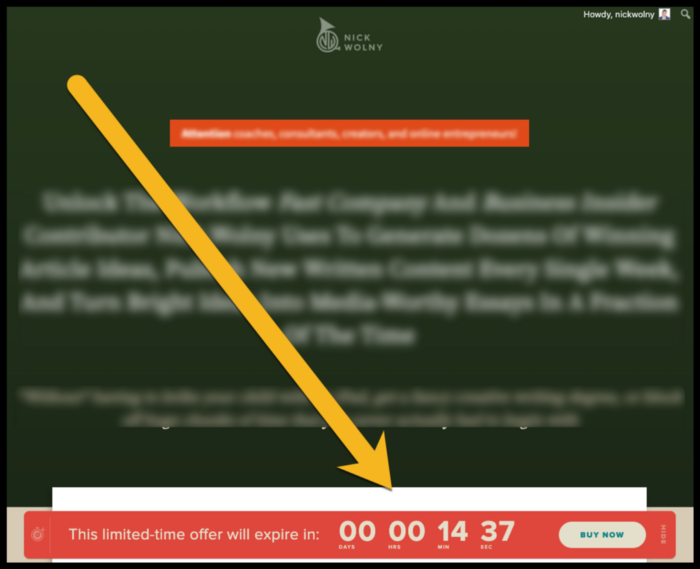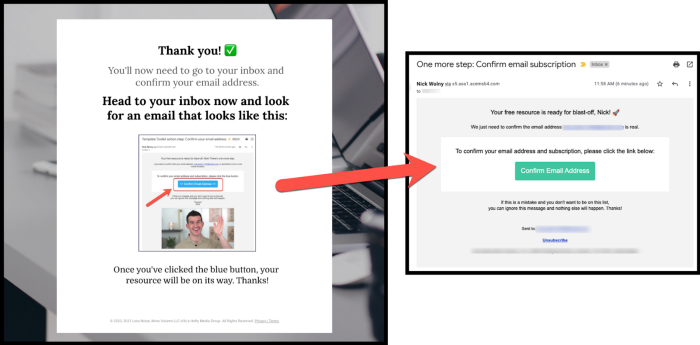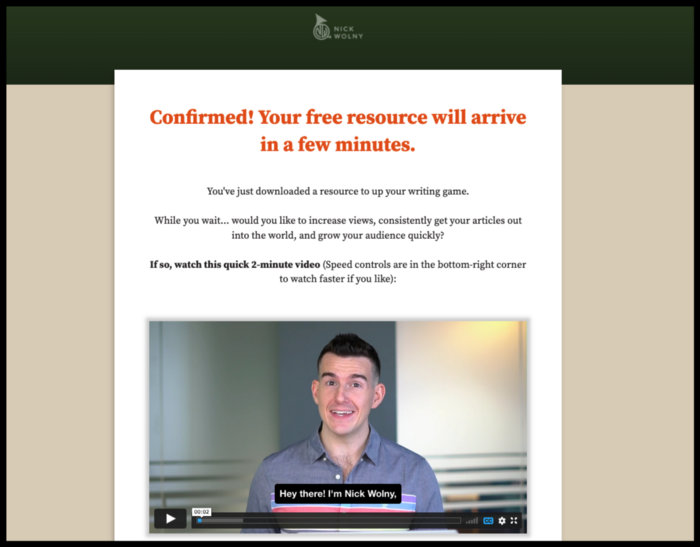I recently filmed a case study for countdown timer software company Deadline Funnel. And if I’m being honest… that’s a sentence I never thought I would type.
You’ve probably seen countdown timers on the internet before:
- You land on a product page and are blasted with a ticking timer that looks like it could be strapped to a bundle of dynamite. 🧨
- A mix of emotions gets whipped up inside your body. Usually, the thought that runs through your head is along the lines of “Ah, shit — I gotta make a decision about this now?!”
- Depending on what you ate for breakfast this morning, your reaction varies. Sometimes you click out right away, and other times you find yourself whipping out your credit card in minutes flat.
My Foray Into Ethical Countdown Timers - Post Outline
For years — years! — I hated these timers. My perspective was (and still is) that big sales decisions shouldn’t be rushed. When your online business is mainly higher-ticket services and packages — I usually charge $3,000 — $30,000/contract — purchasing decisions are carefully considered and rooted in logic.
Then COVID-19 rolled in
And like many of you, my world got turned upside down. Conversations about my four-figure and five-figure consulting packages came to a screeching halt.
Everyone was clutching their dollars tightly, myself included; I suddenly had to pivot my consulting business into more of a creator/infopreneur model. I began packaging up knowledge into courses and other information products and shifted to a more mass-market approach.
I also began promoting limited-time offers: Optional content upgrades offered within a short time window when new subscribers sign up for my email list. The results have been awesome, both in terms of sales and in freeing me up to work on content and consulting efforts.
So what is a countdown timer, exactly? Let’s break down what a countdown timer is, what to consider before setting one up, and how I personally use mine in relation to this platform.
What Are Countdown Timers, Exactly?
In marketing psychology, two of the most potent spices we have to work with are urgency and scarcity.
- Urgency refers to why you should buy something now and not later, and is usually related to time.
- Scarcity also refers to why you should buy something now and not later, but in this case it’s related to availability.
The two mechanisms have a lot of crossover, but they also have some independence. Additionally, there are niche techniques within scarcity and urgency that you probably encounter every week without even realizing it.
These are things like:
- Loss aversion — If you wait, you risk missing out. This is why people will literally take the day off of work to buy Beyoncé concert tickets; the tickets sell out in minutes, and no one wants an opportunity to slip through their fingers
- Passage of time — Bringing attention to the fact that, weeks or months from now, you might still be stagnating in the same place you are today
- Immediacy — The instant gratification that comes with buying or acting on something when we know we will get it now (Popularized by the Stanford Marshmallow Experiment)
A countdown timer enables most if not all of these psychological triggers at once. The same timer carries through the product page, the checkout page, and any other pages you want to include in your marketing campaign. If the timer runs out, clients are redirected to a different page and the offer disappears.
Takeaway: Countdown timers help your prospects overcome procrastination and make a decision now rather than later.
Why Countdown Timers Work
Sounds intense — which is why I stayed away for so long. Here are a few things that shifted my perspective.
You don’t need a huge email list for timers to work
Online entrepreneurship expert Ramit Sethi teaches that the expected conversion rate for an online course when launching to your email list is… 0.5–1%.
This means that, to sell your $50 course and make even $1,500/launch, you need between 3,000 and 6,000 email subscribers ($1,500/$50 = 30 sales; 30/0.5 = 6,000). Obviously, some launches will outperform and others will flop. This 0.5–1% conversion rate is considered successful, y’all.
Even for the most compelling creator or writer, this is… a shit-ton of subscribers. It’s almost better to wait until your list gets to a certain size before you try to promote courses or other offers through traditional “cart opens, cart closes” launch strategy.
When we use a limited-time offer, however, you don’t need a big email list. Every new subscriber experiences the launch individually and can decide for themselves whether or not they want to participate.
You respect your subscribers’ time and attention
After readers subscribe to my list and confirm their email address, the thank-you page invites them to check out my limited-time offer. For readers who take me up on my offer, my timer gives them 15 minutes to make a decision.

Screenshot from author. Countdown timer appears as a sticky footer on sales pages for limited-time offers.
Here’s why the purchasing window is so short: I don’t think you actually need more than 15 minutes to make a purchasing decision about a mini-course.
If you want the course, you buy it, and if you don’t, you don’t. Not all readers want to pay to solve their problems faster, but some do, and for those that do and like my flavor of writing I want to offer them a way to go deeper. We don’t need to have an existential crisis about a $47 mini-course.
I heard a great perspective on sales recently: “The point of a sales container is not to get a yes; it’s to get a decision.” Timers help my readers make a complete decision.
Reminder: Be ethical, plz
If you say the offer is only available at this price for 15 minutes or 24 hours or 7 days… you need to stick to that.
Fake urgency is why consumers hate marketers. And don’t even get me started on the webinars that say they’re live when they’re actually automated. If you’re already lying to me before you’ve even taken my money, how can I expect you to deliver the goods on the backend?
Takeaway: Countdown timers help your readers and prospective customers make decisions.
How I Use Ethical Countdown Timers, Step By Step
Enough theory — let’s look at some screenshots!
Readers join my email list by downloading a freebie of mine. Usually I do a PDF or walkthrough video for my freebie.
I use a double opt-in to cut down on fake email addresses. In a double opt-in, people have to confirm their email address from within their inbox to officially be added to the list. You’ll lose some people here, but if readers aren’t even compelled enough to go back to their inbox and click a button, was your freebie really that valuable? Keep yourself honest; use a double opt-in.
After readers submit their name and email on my landing page, I take them to a page that has crystal-clear instructions on what they should do next.

Screenshot from the author
When new subscribers click the confirmation button, it confirms their address *and* redirects them to a new web page. I use this digital real estate to introduce my limited-time offer and invite them to learn more about it. Sometimes my limited-time offer is a mini-course, and sometimes it’s a workshop replay of mine — the offer depends on what lead magnet people downloaded.
Notice how I specify that the freebie will take a few minutes to arrive, and that my video is two minutes along, implying that they have the time to watch it (And can even watch it at 2x speed if they want). At the bottom of this short web page is a “Learn More” button.

Screenshot from the author
Let’s be clear: Most of my subscribers (About 70% as of this writing) pass on even clicking the Learn More button, which is completely fine. I actually want this; I want to determine relevancy with my new subscribers. If people aren’t interested in learning more, I respect that and want to not bombard them with offers or timers.
Consent-based marketing builds trust with your readers. So when readers are interested, they click to learn more, and I bring them to a sales page that outlines my offer. Readers have 15 minutes to make a decision.
“But can’t I do all this WITHOUT a timer?”
You can. I did at first, because I was still timer-averse at the beginning. And for several months, my sales conversion was okay.
Here’s why this approach gets challenging: People have to have a sense of urgency to buy. If there’s no incentive to buy your course or workshop today, why should I? Why can’t I just bookmark the page and come back to it next week/next month/years from now?
Whether it’s for your services, programs, products, or something else, a succinct time window helps your readers make a complete decision.
Workarounds For Countdown Timers (And Why I Ignore Them)
It’s not lost on me that there are workarounds around ethical timers. This is, after all, the internet. If you find yourself passing on a limited-time offer, and then regretting it later on, here are some ways to potentially mitigate your “non-buyer’s remorse”:
- Use a different email address — if the countdown timer widget someone is using is tied to your email address, try a different one.
- Clear your cookies — Some timers use a cookie to manage the timer process. Clearing your cookies might reset your timers in case you change your mind.
- Wait a few weeks and try again — Some countdown timers, including Deadline Funnel, give an option for the timer or cookie to expire after a certain amount of time. Could be worth a shot.
I honestly don’t obsess over these too much. Rather than invest my energy in cutting off readers who waffle or try to play me, I focus instead on the clients and customers who want to be in the room with me.
Focus on your customers and clients and your energy will be well spent.
Final Thoughts
Ultimately, only you can decide whether you want to incorporate an ethical countdown timer into your marketing. There are many different widgets and softwares that have this feature.
- Use urgency and scarcity to increase action. But be real about it, and draw clear lines in the sand where necessary.
- Let your copy do the talking. You don’t always need thousands of words to make a sale. What you need are the right words in the right order. In this industry, sometimes less is more.
- Treat your readers like the intelligent adults they are. Make offers and sell, but also make your promotional experiences consent-based. Consent is sexy.
Marketing’s modalities continue to shift, but the underlying psychology remains largely the same. Encourage making decisions and you’ll have more clarity along the way as you build your online empire brick by brick.
Thanks for reading. 🙏🏼
Keep up the momentum with one or more of these next steps:
📣 Share this post with your network or a friend. Sharing helps spread the word, and posts are formatted to be both easy to read and easy to curate – you'll look savvy and informed.
📲 Hang out with me on another platform. I'm active on Medium, Instagram, and LinkedIn – if you're on any of those, say hello.
📬 Sign up for my free email list. This is where my best, most exclusive and most valuable content gets published. Use any of the signup boxes in this article, or go to the newsletter page here.
🏕 Up your marketing game: Camp Wordsmith™ is my business and writing program for small business owners and online entrepreneurs. Get instant access to resources and templates guaranteed to make your marketing hustle faster, better, easier, and more fun. (It's also "glamping"-themed – who doesn't love luxurious camping?!) Learn more here.
📊 Hire my marketing company: Hefty Media Group provides consultation and done-for-you services in content marketing. We're a certified diversity supplier with the National Gay & Lesbian Chamber of Commerce, and we'll make you sound damn good via the written word. Learn more here.
© 2021, 2022, Hefty Media Group. All Rights Reserved.


